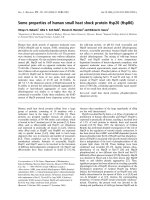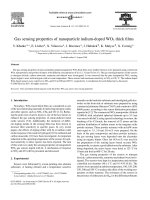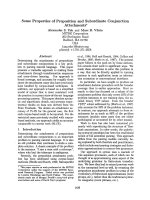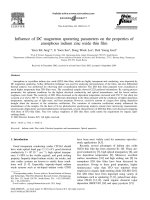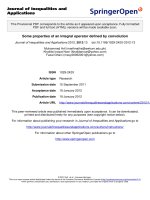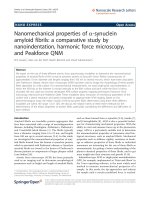Some Properties of TiO 2 Au Nanocomposite Thin Films Produced by Spincoating Method for Applicatio
Bạn đang xem bản rút gọn của tài liệu. Xem và tải ngay bản đầy đủ của tài liệu tại đây (1.02 MB, 8 trang )
<span class='text_page_counter'>(1)</span><div class='page_container' data-page=1>
28
Some Properties of TiO
<sub>2</sub>/Au Nanocomposite
Thin Films Produced by Spincoating Method for Application
in Plasmonic Solar Cells
Nguyen Duy Thien
1,*, Nguyen Tien Thanh
1,
Nguyen Thi Thuy
2, Le Van Vu
1, Dao Khac An
21
<i>Centre for Materials Science, Faculty of Physics, VNU University of Science, </i>
<i>334 Nguyen Trai, Thanh Xuan, Hanoi, Vietnam </i>
<i> 2</i>
<i>Energy Materials and Devices Lab, Institute of Materials Science, (VAST), </i>
<i>18 Hoang Quoc Viet, Cau Giay, Hanoi, Vietnam </i>
Received 20 March 2015
Revised 22 April 2015; Accepted 24 April 2015
<b>Abstract: The TiO</b>2/Au nanocomposite thin films play a very important role in the plasmonic solar
cell. In such as composite systems, the localized surface plasmon resonance (LSPR) of embedded
metal nanoparticles determines the light absorption enhancement of the semiconductive part
(TiO2); hence, enhances the efficiency of the plasmatic solar cell. The characterizations of the
TiO2/Au nanocomposite thin films – such as light absorption, scattering and LSPR capacities -
depend on many parameters: sizes, weight ratio of metal nanoparticles, thickness of the thin film
layers and the arrangements of TiO2/Au composite in integrated-matrix system. In this work, we
outline the preparation method of the TiO2/Au nanocomposite thin films, then we investigate the
effect of technological conditions – such as TiO2/Au mixture solution concentration, TiO2/Au
weight ratio and number of spin-coating layers – to the surface morphology of the nanocomposite
to find out the optimum fabrication conditions. Some experimental results of thin film such as
structural property (X ray diffraction, thin film morforlogy…) and optical property (absorption
coefficience concerning LSPR…) will also be shown and discussed.
<i>Keywords: TiO</i>2/Au thin film, LSPR, plasmonic solar cell.
<b>1. Introduction</b>∗
Recently, fossil energy sources are depleted due to the increasing exploitation of the countries.
Beside, the extraction and over usage have caused many consequences such as environmental
pollution, the greenhouse effect and climate change. Therefore, one of serious challenges to mankind
is to ensure the energy security or energy sustainability. This challenge has to be answered with a
_______
∗
</div>
<span class='text_page_counter'>(2)</span><div class='page_container' data-page=2>
solution to produce the renewable energy sources, One of them is the solution transforms of solar
energy into electrical energy based on photovoltaic cells [1-4]. Up to now there are three solar cell
generations have been developed, among them the plasmonic solar cells, belonging to the third
generation, are promissing and that is promise new type and they are getting the most attention of
scientists [3-8, 9-10]. In the plasmonic solar cells, the most important structure is the structure of the
integrated noble metal nanoparticle (TiO2/Au (Ag….) system. This, so called plasmonic
nanostructures where the plasmonic resonance induces a dipole on the metal nanoparticle, enhance
electric field around the metal nanoparticle, could support the formation of the surface plasmon
resonance in response to a photon flux, localizing electromagnetic energy close to their surfaces. The
enhanced photovoltaic properties from the incorporation of metal nanoparticles/ semiconductor have
been studied for various systems [5 -8,11,12]. So far, the plasmonic solar cells are developed at the
beginning stage that many research issues, including both theoretical and practical problems must be
overcome [5-8, 11-13].
In previous reports, we have also designed and produced some samples of the plasmonic solar
cells, investigated the structural, electrical and optical properties, however, the obtained results of
electrical and optical properties were still limited [14]. In this work we focused on the spincoating
method for fabricating TiO2/Au thin film through two steps: preparation of TiO2/Au sol solution and
using this sol solution for spincoating to create TiO2/Au thin films, after that we have investigated the
effect of technological conditions such as TiO2/Au solution concentration, Au/TiO2 weight ratio and
number of spin-coating layers on structural and optical properties of the TiO2/Au thin films.
<b>2. Experiment </b>
All the precursors with high purity were purchased from commercialized distributors: Chloroauric
acid 99.98 % (HAuCl4), Sodium borohydrid 99.8% (NaBH4) from MERCK, German; pure Titanium
dioxide nanoparticles (TiO2) from Sigma, America and polyvinyl pyrrolidone 98% (PVP – MW 30000
Dal) from Korea. The TiO2/Au composite thin films were prepared by sol-thermal calcinations on
1cm× 2cm ITO substrates (from France) and sheet resistance of 200-250 Ω/square.
Firstly, to create 5% of Au/TiO2 weight ratio composite (labeled as TiO2/Au 5%): 25 mg of TiO2
was dispersed into 25 ml of HAuCl4 1mM, which contained 250 mg PVP. The mixture was gently
mixed by magnetic stirring to obtain a homogenous aqueous solution. After that, we added a small
amount of ice-cold 0.01M NaBH4 to Au
3+
from chloroauric acid to Au0. The solution color changed to
a typical dark red. We have used centrifugation to get higher concentration solution, then the solution
was dispensed in ethanol – later called xerogel, which contained the mixture of TiO2 and Au
nanoparticles. Secondly, we created TiO2/Au thin film xerogel on ITO substrate by spin-coating
</div>
<span class='text_page_counter'>(3)</span><div class='page_container' data-page=3>
(labeled as TiO2/Au 10%) was prepared by the same method, where the used amount of HAuCl4 1mM
solution was 50mL.
In this paper We selected the TiO2/Au 5% composite for next investigations. First, different
concentrations TiO2/Au 5% composite were prepared by increasing the amount of added TiO2
nanoparticles, while the weight ratio of Au/TiO2 was kept constant. Typically, the mixture of
TiO2/Au in PVP in ethanol was diluted to different concentrations (Table 1). The concentrations of the
samples were defined by the precursor TiO2 colloids in xerogel solution.
<b>Table 1. The precursor amounts used in different the composite thin films on ITO substrates (samples) for </b>
investigating the effect of the TiO2/Au precursor concentration on the filling efficiency
Sample
Amount of precursor TiO2
nanoparticles in xerogel
solution
Amount of initial TiO2/Au
mixture before
centrifugation
Amount of added
ethanol in xerogel
M1 10mg/ml 25ml 2500 µl
M2 40mg/ml 25ml 625 µl
M3 50mg/ml 25ml 500 µl
The crystal structure of the synthesized products was analyzed by X-ray diffraction (XRD) using
X-ray diffractometer Siemens D5005 , Bruker, Germany, with Cu-Kα1 radiation (λ = 0.154056 nm).
The surface morphology of the samples was investigated by using a Nova NANOSEM 450 scanning
electron microscope and Dektak 150 Profiler, Vecco, USA. The UV-vis absorption spectra were
measured by Shimadzu UV 2450 PC spectrometer, Japan.
<b>3. Results and discussions </b>
<i>3.1. Crystal structure and morphology </i>
<b>Fig. 1. X-ray diffraction parttern of TiO</b>2/Au nanocomposite thin film prepared by calcinated spin-coating
</div>
<span class='text_page_counter'>(4)</span><div class='page_container' data-page=4>
Fig. 1 shows XRD pattern ofTiO2/Au 5% nanocomposite thin film spincoated on ITO substrates,
where the inset shows the picture of the TiO2 thin film (A) and TiO2/Au composite thin film (B) on
ITO substrate. TiO2/Au nanocomposite thin film exhibits characteristic dark red of gold nanoparticles.
The typical peaks of ITO substrate arise at 30.5o, 37.1o, 51.0o and 60.4o, corresponding to (222), (400),
(440) and (622) planes, respectively. Existence of TiO2 in nanocomposite shows in the peaks at 25.3o,
27.5 o, 36.0o, 41.3o, 48.1o, 54.1o and 62.8o, coinciding with previous published results, which relate
to {101}, {110}, {112}, {111}, {200}, {211} and (213) of anatase structure of TiO2 [15]; while the
presence of Au nano-colloids is demonstrated via typical peaks face-centered cubic structure of Au at
38.2o, 44.4o and 64.6o corresponding to [111], [200] and [220], respectively .(CAS: 7440-57-5) [16]
<i>3.2. The effect of the TiO2/Au mixture solution concentration </i>
Fig. 2. SEM images of TiO2 /Au nanocomposite thin films spincoated on ITO substrates with different
concentrations of TiO2/Au sol solution: a) 10mg/ml, b) 40mg/ml and c) 50mg/ml.
Scanning electron microscopic (SEM) images of TiO2/Au nanocomposite thin films with different
concentrations of TiO2/Au sol solution on ITO substrate are presented in the Figure 2. In M1 sample,
when the solution concentration of TiO2/Au is 10mg/ml, there are a lot of voids on ITO surface (A).
Total filled-up area has decreased significantly when the TiO2/Au sol solution concentrations are
increased (Fig 2b). Especially, the unfilled areas disappear when TiO2/Au solution concentration are
50mg/ml (Fig 2c). In further investigations, we use this concentration of TiO2/Au precursors to
synthesize TiO2/Au nanocomposite thin films.
<i>3.3. Thickness control </i>
The thickness of TiO2/Au nanocompsite thin film depends on various parameters, such as viscosity
and concentration xerogel solution, rotation speed while spin-coating... In this works, we fixed all of
these parameters and control thickness of films via controlling times of repeating spincoating TiO2/Au
</div>
<span class='text_page_counter'>(5)</span><div class='page_container' data-page=5>
Fig. 3. The Plot dependence of the TiO2/Au nanocomposite thin film thickness on times of repeating spincoating
(a); and SEM image of four layers TiO2/ Au nanocomposite thin film (b).
As we increased the thickness of the TiO2/Au by repeating the spin coating – calcinations process
multiple times, the composite thin film could be considered as a multilayer of films and thickness of
each layer was about 480 nm ± 77.5 nm (Fig. 3A). Table 2 shows TiO2/Au nanocomposite thin films
thickness measured by Dektak 150 equipment system when the coating time was 1, 2, 3 and 4,
respectively
Table 2. Thickness of TiO2/Au nanocomposite tin film when spin- on 1, 2, 3 and 4 layer
Multilayer <sub>1-time coating 2-time coating 3- time coating 4-time coating </sub>
Thickness (nm) 483.0 950.0 1460.0 2190.0
Standard error (nm) 77.5 77.5 77.5 77.5
Cross-section SEM image of the 4-time spin-coated TiO2/Au 5% composite on ITO substrate is
shown in Figure 3B. No layer boundary could be observed disjunction occurs. Continuous one layer
thin film was formed this result implied that the obtained films were homogenous
<i>3.4. Optical properties </i>
</div>
<span class='text_page_counter'>(6)</span><div class='page_container' data-page=6>
<b>Fig. 4. The absorption spectra concerning the Localized Surface Plasmon Resonance (LSPR) of TiO</b>2/Au 0%,
TiO2/Au 5%, TiO2/Au 10% nanocomposite thin films.
Light scattering is, in general, the attenuation of a beam of light by metal nanoparticles, either by
absorption or scattering. The sum of these two parts is known as the extinction. For particles with
diameters well below the wavelength of light, a point dipole model describes well the absorption and
scattering of light. The scattering and absorption cross-sections, Cscat and Cabs, respectively are given
by the followings [17-19]:
,
)
2
(
6
1
<sub>4</sub> 2α
λ
π
π
=
<i>scat</i>
<i>c</i>
2
Im
α
2,
λ
π
=
<i>abs</i>
<i>c</i>
where
+
−
=
2
/
1
/
3
<i>m</i>
<i>p</i>
<i>m</i>
<i>p</i>
<i>V</i>
ε
ε
ε
ε
α
<sub> (4.1 a,b,c) </sub><i>Here V is the particle volume, εp</i> is the dielectric function of the particle and ε<i>m </i>is the dielectric
function of the embedding medium. We can see that when ε<i>p = -</i>2εm, the particle polarizability will
become very large. This is known as the surface plasmon resonance. This sometime is called the
dipole plasmon resonance of the particle. At surface plasmon resonance condition the scattering
cross-section can well exceed the geometrical cross cross-section of the particle.
Concerning our obtained results, in general, the LSPR absorption properties of the TiO2/Au 0%,
TiO2/Au 5% and TiO2/Au 10% are illustrated in Figure 4. The results show that the absorption spectra
enhanced in the range of 500 nm - 600 nm and absorption intensity increases when Au concentration
being in the sample increases. We used absorption of TiO2 thin film without Au nanoparticle
(TiO2/Au 0%) as the base level. In absorption range from 350 nm to 900nm an experimental
exponential (function not shown) occurs. TiO2 particles usually have good light absorption at near UV
</div>
<span class='text_page_counter'>(7)</span><div class='page_container' data-page=7>
TiO2/Au 5% and of TiO2/Au 10%. An exponential decay was employed as baseline (see Fig. 4 –
baseline fitted line) for the region of [350nm-400nm] and [750nm-900nm], where the typical surface
Plasmon resonance of gold nanoparticles does not occur [16, 20]. Then the baselines are distracted
from the original spectra to get the different spectra (Fig. 4 – inset) of TiO2/Au 5% composite and of
TiO2/Au 10% composite thin films,respectively. We can see that there are enhancements arising at
characteristic SPR peak of Gold nanoparticles around 540 nm. We also see there are abnormal peaks
arising at near-UV region from 430 nm to 450 nm. The origin of these peaks is still unrevealed. They
might relate to the phenomenon of the presence of a thin Au coat around the TiO2 particles during
synthesis process. AuCl4- ions from HAuCl4 adsorbed on surface of the semiconductor nanoparticles
during mixing and these ions were reduced to Au atom then attached on the surface of the TiO2
particles meanwhile the free ions were reduced to Au nanoparicles. The presence of this enhancement
also occurred at the absorption spectra of xerogel solutions (data not shown). However, more
investigation are needed to clarify the origin of this enhancement.
<b>4. Conclusions </b>
In conclusion, we have synthesized TiO2/Au nanocomposite thin film from TiO2/Au solution with
different Au/TiO2 weight ratio on the ITO substrates by spin coating method. Our results show that the
whole ITO substrate is filled with relatively homogenous TiO2/Au composite at 50 mg/ml
concentration of precursor TiO2 nanopartciles in xerogel solution. Thickness of the thin film can be
increased by multiple-time coating, while the homogeneity of the composite layer does not change. In
our spinning conditions, each coating time would create reproducibly 480 nm ± 77 nm thick layer,
which shows that we have to coat the ITO substrate at least 4 times to reach usual thickness of
plasmonic solar cells.
Based on the produced TiO2/Au thin film we have investigated the absorption coefficiency
concerning the LSPR of the thin film. The result show that 5% of Au/TiO2 weight ratio is the critical
ratio to allow LSPR of the Au particles in the composite thin film. Higher amount of Au in the
complex results in higher LSPR intensity. Besides, there is unrevealed absorption enhancement arisen
at the region from 400 nm to 450 nm, which increases the light absorption ability of the thin film.
<b>Acknowledgments </b>
</div>
<span class='text_page_counter'>(8)</span><div class='page_container' data-page=8>
<b>References </b>
[1] O’Regan B and Grätzel M, A low-cost, high-efficiency solar cell based on dye-sensitized colloidal TiO2 films,
Nature 353 (1991), 737-740.
[2] Grätzel M, Photoelectrochemical cells, Nature, 414 (338) (2001), 338 – 344.
[3] Martin A. Green, Thin-film solar cells: review of materials, technologies and commercial status, J Mater Sci:
Mater Electron, 18 (2007), S15–S19.
[4] S. Pillai n, M.A.Green, Plasmonics for photovoltaic applications, Solar Energy Materials & Solar Cells, 94
(2010), 1481–1486.
[5] Yang Tian and Tetsu Tatsuma, Mechanisms and Applications of Plasmon-Induced Charge Separation at TiO2
Films Loaded with Gold Nanoparticles, J. AM. CHEM. SOC, 127 (2005), 7632- 7637.
[6] Harry a. Atwater and Albert Polman; Plasmonics for improved photovoltaic devices, nature materials, 9 (2010),
205 - 2013.
[7] Wei Hao Lai, Yen Hsun Su, Lay Gaik Teoh , Min Hsiung Hon, Commercial and natural dyes as photosensitizers
for a water-based dye-sensitized solar cell loaded with gold nanoparticles, Journal of Photochemistry and
Photobiology A: Chemistry, 195 (2008), 307–313.
[8] Stacey D. Standridge, George C. Schatz, and Joseph T. Hupp, Toward Plasmonic Solar Cells: Protection of Silver
Nanoparticles via Atomic Layer Deposition of TiO, Langmuir, 25 (5) (2009), 2596-2600.
[9] Changwoo Nahm, Hongsik Choi, Jongmin Kim,Dae-Ryong Jung,Chohui Kim,Joonhee Moon, Byungjoo Lee, and
Byungwoo Park, The effects of 100 nm-diameter Au nanoparticles on dye-sensitized solar cells, Appl. Phys. Lett.
99 (2011), 253107.
[10] Yen-Hsun Su, Yuan-Feng Ke, Shi-Liang Cai and Qian-Yu Yao, Surface plasmon resonance of layer-by-layer
gold nanoparticles induced photoelectric current in environmentally-friendly plasmon-sensitized solar cell, Light:
Science & Applications, 1 (2012), e14; doi:10.1038/lsa.2012.14 _ 2012 CIOMP. All rights reserved
2047-7538/12
[11] Vivian E. Ferry, Jeremy N. Munday, and Harry A. Atwater, Design Considerations for plasmonic
Photovoltaics, Adv. Mater, 22 (2010), 4794–4808.
[12] Tanujjal Bora, Htet H. Kyaw1, Soumik Sarkar, Samir K. Pal, and Joydeep Dutta, Highly efficient ZnO/Au
Schottky barrier dye-sensitized solar cells: Role of gold nanoparticles on the charge-transfer process, Beilstein J.
Nanotechnol, 2 (2011), 681–690.
[13] Van Hieu Nguyen and Bich Ha Nguyen, Visible light responsive titania-based nanostructures for photocatalytic,
photovoltaic and photoelectrochemical, applications ; Adv. Nat. Sci.: Nanosci. Nanotechnol. 3 (2012) 023001
(9pp) doi:10.1088/2043-6262/3/2/023001.
[14] Dao Khac An, Pham Duy Long, Phan Anh Tuan, Vu Van Cat, Ngo Thi Hong Le, Nguyen Thi Mai Huong,
Nguyen Duy Thien and LeVan Vu, On the plasmonic nano solar cells and several preliminary research results,
invited talk (K-V1-12), The 6th International Workshop on Advanced Materials Science and Nanotechnology
(IWAMSN2012) - October 30-November 02, 2012- Ha Long City, Vietnam.
[15] Yu Zou, Zhi-An Wang, Xiao-Hua Lan and Ning-Kang HuangAnatase Phase TiO2 Anode of a Dye-Sensitized
Solar Cell Prepared by using RMFMS, Journal of the Korean Physical Society, Vol. 55, No. 6, December 2009,
pp. 2650-2653.
[16] Nguyen Duy Thien, Chu Dinh Kiem, and Nguyen Ngoc Long, Synthesis of Gold Nanorods from Metallic Gold
by a Sonoelectrochemical Method, e-J. Surf. Sci. Nanotech. Vol. 9 (2011) 466-468.
[17] Dufort C.C and Dragnea B, Annu, Rev. Phys. Chem, 61 (2010), 323-344.
[18] K.R. Catchpole and A. Polman, Plasmonic solar cells, 16 (26) (2008), 21793 – 21800
[19] Liz – Marzan L. M, Nano metals: Formation and color, Materialstoday, 2004, 28-31.
[20] Jeno Gubicza, Janos L.Labar, Luu Manh Quynh, Nguyen Hoang Nam, Nguyen Hoang Lương. Materials
Chemistry and Physics, 138 (2013), 449 – 453.
</div>
<!--links-->

